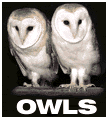

The Barred Owl (Strix varia) is large at from 17 to 24 inches with a 44 inch wingspan. It is all gray to grayish-brown and inhabits river woodlands. It is common in southern swamps, less common
but widespread in northern woods. Found mostly in the Eastern half of the United States, this owl's range extends across southern Canada and into the Pacific Northwest where its competition with the endangered Spotted Owl is cause for concern.
This owl feeds on mice, frogs, squirrels, rabbits and
similar small prey. Even its smaller cousin, the screech owl, has been included in its diet.
The Barred Owl prefers to nest in the cavity of a tree or the abandoned nest of a hawk or crow. The clutch consists of from two to three white eggs. The eggs hatch in four weeks and the young owls fledge four to five weeks later.
The Barred Owl's lifespan is approximately 10 years in the wild. It has few predators.
The coloration of this owl is barred crosswise on the chest and streaked lengthwise on the belly, with a white spotted back. Its large eyes are brown. It has a yellow beak and no head tufts. The distinctive call is a series of eight loud hoots delivered in a series of four: hoohoo, hoohoo, hoohoo, hoohoooaw. It has been said the call sounds like, "Who cooks for you; who cooks for you all." This nocturnal owl frequently calls during the day.




